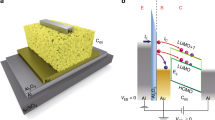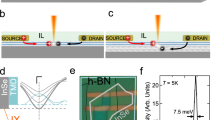Abstract
Magnetic-field-dependent injection current, namely magnetoresistance, is readily observable in organic semiconductor devices. This provides a non-contact approach to tune organic optoelectronic properties by using a magnetic field. Here, we demonstrate that this magnetoresistance can be changed between positive and negative values by adjusting the dissociation and charge reaction in excited states through changing the bipolar charge injection in organic light-emitting diodes. This finding reveals that the magnetic-field-dependent generation of secondary charge carriers from the dissociation and charge reaction affects the injection current by forming further space charges at the organic–electrode interfaces and therefore accounts for the tunable magnetoresistance. Furthermore, the dissociation and charge reaction have opposite dependences on magnetic field in the generation of secondary charge carriers, consequently leading to negative and positive magnetoresistance, respectively. As a result, adjusting the dissociation and charge reaction in excited states provides a convenient pathway to tune the magnetoresistance in organic semiconductors.
This is a preview of subscription content, access via your institution
Access options
Subscribe to this journal
Receive 12 print issues and online access
$259.00 per year
only $21.58 per issue
Buy this article
- Purchase on Springer Link
- Instant access to full article PDF
Prices may be subject to local taxes which are calculated during checkout






Similar content being viewed by others
References
Taliani, C. et al. Organic-inorganic hybrid spin-valve: A novel approach to spintronics. Phase Transit. 75, 1049–1058 (2002).
Xiong, Z. H., Wu, D., Vardeny, Z. V. & Shi, J. Giant magnetoresistance in organic spin-valves. Nature 427, 821–824 (2004).
Kalinowski, J., Cocchi, M., Virgili, D., Di Marco, P. & Fattori, V. Magnetic field effects on emission and current in Alq(3)-based electroluminescent diodes. Chem. Phys. Lett. 380, 710–715 (2003).
Kalinowski, J., Cocchi, M., Virgili, D., Fattori, V. & Di Marco, P. Magnetic field effects on organic electrophosphorescence. Phys. Rev. B 70, 205303 (2004).
Davis, A. H. & Bussmann, K. Large magnetic field effects in organic light emitting diodes based on tris(8-hydroxyquinoline aluminum) (Alq(3))/IN,N′-Di(naphthalen-1-yl)-N,N′diphenyl-benzidine (NPB) bilayers. J. Vac. Sci. Technol. A 22, 1885–1891 (2004).
Francis, T. L., Mermer, Ö., Veeraraghavan, G. & Wohlgenannt, M. Large magnetoresistance at room temperature in semiconducting polymer sandwich devices. New J. Phys. 6, 185–192 (2004).
Sheng, Y. et al. Hyperfine interaction and magnetoresistance in organic semiconductors. Phys. Rev. B 74, 045213 (2006).
Wu, Y. & Hu, B. Metal electrode effects on spin–orbital coupling and magnetoresistance in organic semiconductor devices. Appl. Phys. Lett. 89, 203510 (2006).
Desai, P. et al. Magnetoresistance and efficiency measurements of Alq3-based OLEDs. Phys. Rev. B 75, 094423 (2007).
Wu, Y., Xu, Z., Hu, B. & Howe, J. Tuning magnetoresistance and magnetic field-dependent electroluminescence through mixing strong-spin–orbital-coupling molecule and weak-spin–orbital-coupling polymer. Phys. Rev. B 75, 035214 (2007).
Fesser, K., Bishop, A. R. & Campbell, D. K. Optical absorption from polarons in a model of polyacetylene. Phys. Rev. B 27, 4804 (1983).
Bassler, H. Injection, transport and recombination of charge carriers in organic light-emitting diodes. Polym. Adv. Technol. 9, 402–418 (1998).
Kalinowski, J. Electroluminescence in organics. J. Phys. D 32, R179–R250 (1999).
Kalinowski, J., Szmytkowski, J. & Stampor, W. Magnetic hyperfine modulation of charge photogeneration in solid films of Alq3 . Chem. Phys. Lett. 378, 380–387 (2003).
Wilkinson, J., Davis, A. H., Bussmann, K. & Long, J. P. Evidence for charge-carrier mediated magnetic-field modulation of electroluminescence in organic light-emitting diodes. Appl. Phys. Lett. 86, 111109 (2005).
Köhler, A. et al. UV photocurrent spectroscopy in poly(p-phenylene vinylene) and derivatives. Synth. Met. 84, 675–676 (1997).
Muller, J. G. et al. Ultrafast dynamics of charge carrier photogeneration and geminate recombination in conjugated polymer: Fullerene solar cells. Phys. Rev. B 72, 195208 (2005).
Szmytkowski, J., Stampor, W., Kalinowski, J. & Kafafi, Z. H. Electric field-assisted dissociation of singlet excitons in tris-(8-hydroxyquinolinato) aluminum (III). Appl. Phys. Lett. 80, 1465 (2002).
Kalinowski, J. et al. Coexistence of dissociation and annihilation of excitons on charge carriers in organic phosphorescent emitters. Phys. Rev. B 74, 085316 (2006).
Pope, M. & Swenberg, C. E. Electronic Processes in Organic Crystals 2nd edn (Oxford Univ. Press, Oxford, 1999).
Wittmer, M. & Zschokke-Gränacher, I. Exciton-charge carrier interactions in the electroluminescence of crystalline anthracence. J. Chem. Phys. 63, 4187–4194 (1975).
Ern, V. & Merrifield, R. E. Magnetic field effect on triplet exciton quenching in organic crystals. Phys. Rev. Lett. 21, 609–611 (1968).
Tolstov, I. V. et al. On the role of magnetic field spin effect in photoconductivity of composite films of MEH-PPV and nanosized particles of PbS. J. Lumin. 112, 368–371 (2005).
Kalinowski, J. & Signerski, R. Exciton-enhanced double injection current in tetracene crystals. Phys. Status Solidi B 118, K147–K150 (1983).
Kalinowski, J. & Godlewski, J. Magnetic field effects on recombination radiation in tetracene crystal. Chem. Phys. Lett. 36, 345 (1975).
Birks, J. B. Organic Molecular Photophysics (Wiley, London, 1975).
Frenkel, J. On pre-breakdown phenomena in insulators and electronic semiconductors. Phys. Rev. 54, 647–648 (1938).
Onsager, L. Initial recombination of ions. Phys. Rev. 54, 554–557 (1938).
Doubleday, C. Jr, Turro, N. J. & Wang, J. F. Dynamics of flexible triplet biradicals. Acc. Chem. Res. 22, 199–205 (1989).
Hu, B., Wu, Y., Zhang, Z., Dai, S. & Shen, J. Effects of ferromagnetic nanowires on singlet and triplet exciton fractions in fluorescent and phosphorescent organic semiconductors. Appl. Phys. Lett. 88, 022114 (2006).
Wu, Y., Hu, B., Howe, J., Li, A-P. & Shen, J. Spin injection from ferromagnetic nanoclusters into organic semiconducting polymers. Phys. Rev. B 75, 075413 (2007).
Ito, F., Ikoma, T., Akiyama, K., Watanabe, A. & Tero-Kubota, S. Carrier generation process on photoconductive polymer films as studied by magnetic field effects on the charge-transfer fluorescence and photocurrent. J. Phys. Chem. B 109, 8707–8717 (2005).
Kalinowski, J. et al. Quenching effects in organic electrophosphorescence. Phys. Rev. B 66, 235321 (2002).
Graupner, W., Partee, J., Shinar, J., Leising, G. & Scherf, U. Dynamics of long-lived polarons in poly(para-phyenylene)-type ladder polymers. Phys. Rev. Lett. 77, 2033–2036 (1996).
Stampor, W. Electromodulation of fluorescence in hole-transporting materials (TPD, TAPC) for organic light-emitting diodes. Chem. Phys. 256, 351–362 (2000).
Xu, Z., Wu, Y. & Hu, B. Dissociation processes of singlet and triplet excitons in organic photovoltaic cells. Appl. Phys. Lett. 89, 131116 (2006).
Köhler, A., Wittmann, H. F., Friend, R. H., Khan, M. S. & Lewis, J. Enhanced photocurrent response in photocells made with platinum-poly-yne/C60 blends by photoinduced electron transfer. Synth. Met. 77, 147–150 (1996).
Sariciftci, N. S., Smilowitz, L., Heeger, A. J. & Wudl, F. Photoinduced electron-transfer from a conducting polymer to buckminsterfullerene. Science 258, 1474–1476 (1992).
Wohlgenannt, M. & Vardeny, Z. V. Spin-dependent exciton formation rates in π-conjugated materials. J. Phys. Condens. Matter 15, R83–R107 (2003).
Finkenzeller, W. J. & Yersin, H. Emission of Ir(ppy)(3). Temperature dependence, decay dynamics, and magnetic field properties. Chem. Phys. Lett. 377, 299–305 (2003).
Salis, G., Alvarado, S. F., Tschudy, M., Brunschwiler, T. & Allenspach, R. Hysteretic electroluminescence in organic light-emitting diodes for spin injection. Phys. Rev. B 70, 085203 (2004).
Geacintov, N. E., Pope, M. & Fox, S. Magnetic field effects on photo-enhanced currents in organic crystals. J. Phys. Chem. Solids 31, 1375–1379 (1970).
Levinson, J., Weisz, S. Z., Cobas, A. & Rolon, A. Determination of the triplet exciton-trapped electron reaction rate constant in Anthracene crystals. J. Chem. Phys. 52, 2794–2795 (1970).
Helfrich, W. Destruction of triplet excitons in Anthracene by injected electrons. Phys. Rev. Lett. 16, 401–403 (1966).
Brabec, C. J. et al. Tracing photoinduced electron transfer process in conjugated polymer/fullerene bulk heterojunctions in real time. Chem. Phys. Lett. 340, 232–236 (2001).
Steiner, U. E. & Ulrich, T. Magnetic field effects in chemical kinetics and related phenomena. Chem. Phys. 89, 51–147 (1999).
Ganzorig, C. & Iizumi, Y. A possible mechanism for enhanced electrofluorescence emission through triplet-triplet annihilation in organic electroluminescent devices. Appl. Phys. Lett. 81, 3137–3139 (2002).
Prigodin, V. N., Bergeson, J. D., Lincoln, D. M. & Epstein, A. J. Anomalous room temperature magnetoresistance in organic semiconductors. Synth. Met. 156, 757–761 (2006).
Parker, I. D. Carrier tunneling and device characteristics in polymer light-emitting diodes. J. Appl. Phys. 75, 1656–1666 (1994).
Eastman, D. E. Photoelectric workfunctions of transition, rare-earth, and nobel metals. Phys. Rev. B 2, 1–2 (1970).
Acknowledgements
This research was supported by the Airforce Office of Scientific Office (FA9550-06-10070) and the National Science Foundation Career Award (ECCS-0644945). Partial support from the Center for Materials Processing and Joint Institute of Advanced Materials Laboratory at the University of Tennessee is also acknowledged.
Author information
Authors and Affiliations
Corresponding author
Rights and permissions
About this article
Cite this article
Hu, B., Wu, Y. Tuning magnetoresistance between positive and negative values in organic semiconductors. Nature Mater 6, 985–991 (2007). https://doi.org/10.1038/nmat2034
Received:
Accepted:
Published:
Issue Date:
DOI: https://doi.org/10.1038/nmat2034
This article is cited by
-
Spin-orbital coupling and slow phonon effects enabled persistent photoluminescence in organic crystal under isomer doping
Nature Communications (2021)
-
Tunable magnetoresistance of core-shell structured polyaniline nanocomposites with 0-, 1-, and 2-dimensional nanocarbons
Advanced Composites and Hybrid Materials (2021)
-
Tunable positive magnetoresistance of magnetic polyaniline nanocomposites
Advanced Composites and Hybrid Materials (2021)
-
Fitting the magnetoresponses of the OLED using polaron pair model to obtain spin-pair dynamics and local hyperfine fields
Scientific Reports (2020)
-
Investigation of negative magneto-conductance properties of cobalt phthalocyanine thin films
SN Applied Sciences (2020)



